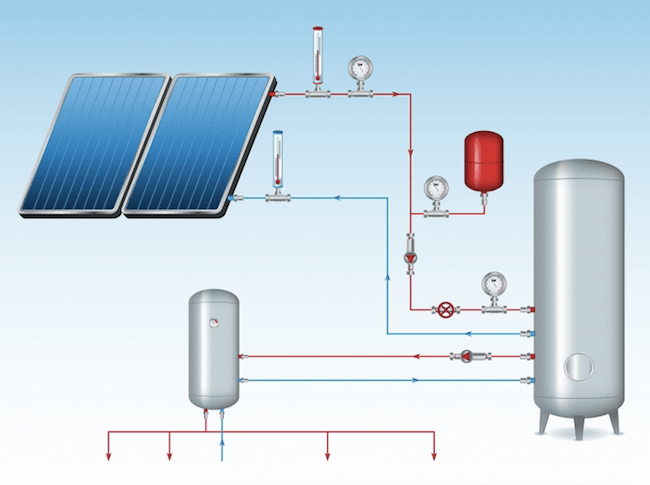Alternative investment funds surge predicted via UCITS and AIF frameworks


John Deere offers all-electric tractor to curb pollution


2017 IRENA Assembly Showcases Global Push for Renewables


If you're looking for some good news to chase away the clouds looming over the U.S. renewable energy picture, now is your chance. The International Renewable Energy Agency convened its 2017 Assembly in Abu Dhabi this weekend, and TriplePundit is there to bring you the latest news on the growth of renewables and the decarbonization of the global economy.
Regardless of any downtick in the U.S. renewables market over the next few years (for the record, that probably won't happen), the IRENA event demonstrates that global energy leaders are dedicated to accelerating the decarbonization movement. As a guest of IRENA, TriplePundit will also pick out some key highlights from the World Future Energy Summit, including hundreds of exhibitors showcasing renewables, transportation and other sustainable technologies.
IRENA and renewable energy
As indicated by its name, IRENA has renewables baked into its mission. The agency's roots go all the way back to the 1981 United Nations Conference on New and Renewable Sources of Energy in Nairobi, Kenya.
The idea of coordinating international efforts on renewables was kicked around for many years (way too many, some would say), until momentum started to build after the World Summit for Sustainable Development 2002 in Johannesburg, South Africa.
Preparations began in earnest to create the new agency, and IRENA was finally launched in 2009, with the mission of promoting "the widespread adoption and sustainable use of all forms of renewable energy, in the pursuit of sustainable development, energy access, energy security and low-carbon economic growth and prosperity."
In a coincidence of timing, 2009 was the first year in office for outgoing U.S. President Barack Obama, whose two terms saw the American market for renewables develop at a feverish pace.
IRENA has also accelerated rapidly in the past eight years. It now spans almost the entire globe, with 149 member states plus the European Union, and 27 more states in the process of coming on board.
Catalyzing action on renewables
The 2017 IRENA Assembly convened on Saturday and Sunday of last week. In advance of the weekend event, IRENA held a forum for legislators on Friday called "Renewable Energy – the Role of Legislators in Catalyzing Action.”
This event aimed to explore the challenges different countries face in terms of policymaking, legislation and support for legislative action on renewable energy.
That topic is certainly of interest here in the U.S. Incoming President Donald Trump is all but certain to try unspooling the renewable energy progress that took place under the Obama administration. And stakeholders are already gearing up to let their legislative representatives know where they stand. That includes key American business leaders, as well as environmental organizations.
Business leaders will likely continue ramping up their investments in clean energy regardless of a change in national policy. But these individual efforts are no substitute for the kind of rapid, efficient transformation needed to maintain the global economy.
Here's IRENA Director-General Adnan Z. Amin explaining the importance of national policy in driving the adoption of renewables in the global marketplace:
“Lawmakers have a rich history of creating the policy and legal frameworks that can drive renewable energy deployment. Their role is even more critical as governments look to transform their energy infrastructure and markets."By bringing together lawmakers from around the world concerned about energy issues, IRENA can better support their efforts to accelerate the energy transition.”
To set the tone for acceleration, during the forum IRENA released a new report detailing the renewable energy potential in Europe's southeastern countries.
Titled "Cost-Competitive Renewable Power Generation: Potential across South East Europe," the report sums up potential in the region, where significant renewable energy resources have yet to be developed. The overall potential adds up to 740 gigawatts or more:
"... The region’s wind energy (532 GW) and solar PV (120 GW) potential is largely untapped, and 127 GW of this overall renewable energy potential could be implemented in a cost-competitive way today. The report says this figure could rise further, to above 290 GW, if more favorable cost of capital is considered for the region."
In addition to covering policymaking tools, the Friday meeting addressed the all-important financing mechanisms needed to accelerate change, and the availability of databases, analytical reports and other forms of support for policymakers.
The 2017 Assembly
At the Assembly this weekend, TriplePundit paid particular attention to several key events including a session on accelerating the corporate sourcing of renewables, a high-level roundatable on innovations that will drive the "next stage of the power sector transformation," another high-level round table on off-grid renewable energy, and a discussion of the driving forces behind decarbonization.
If all goes as scheduled, we will also bring you several exclusive interviews focusing on innovative technology and renewables.
In the coming week, we'll also give you firsthand news from the World Future Energy Summit and exhibition hall, take a closeup look at the sustainable cities experiments going on at Masdar City, and visit a massive power plant that has overcome the challenges of producing utility-scale solar power in harsh desert conditions.
Stay tuned!
Photo (cropped): via IRENA
How Consumer Electronics Are Radically Redesigning Our Cars


Stop thinking of cars as a motor and wheels. Instead, think of them in terms of computer chips, graphic cards and batteries. It is consumer electronics, rather than mechanical systems like combustion engines, that will define our vehicles in the 21st century.
That future, where cars are more like smartphones than machines, was on full display at the 2017 Consumer Electronics Show and North American International Auto Show this month.
The players driving the consumer electronics car revolution
These companies and stakeholders -- and their technologies -- stole the show at CES and NAIAS:
- Car manufacturers. Auto manufacturers are all introducing cars designed around consumer electronics. For example, GM’s all-electric Chevy Bolt won NAIAS Car of the Year. However, all is not good among car manufacturers. Their culture is being challenged by the speed and scale of innovation in consumer electronics. Auto manufacturers are now opening offices in Silicon Valley in an attempt to keep pace with this technology center's ability to commercialize distributive technologies.
- Google, Tesla and Uber. Silicon Valley companies like Google, Tesla and Uber are driving the autonomous vehicle revolution. Autonomous cars are based on prediction software that converts big data into machine learning. Connect learning machines to an Internet of Things (IoT) mesh, and autonomous operations is the result. This tech future will shift consumer interest away from the driving experience and toward convenience, point-to-point speed, digital connectivity and lower cost.
- Intel, Nvidia and Amazon. Artificial intelligence (AI) is the emerging disruptive technology that will reshape our homes, offices, factories, vehicles and lives. Companies like Intel and Nvidia are AI chip leaders. AI chips power AI devices like Amazon’s Alexa, the current product sales leader in linking humans to IoT. Auto manufacturers like Ford are experimenting with how to connect their cars to Alexa.
- Ride-sharing giants. Ride-sharing services, available at the touch of a smartphone button, are undermining vehicle ownership’s economics and convenience. The commercial future is an an algorithm that will enable on-demand delivery of an autonomous vehicle. Clicking an app will deliver an autonomous vehicle. It can be whatever you need: a car, truck or van. It will take you where you want to go and then park itself awaiting your return or move on to another human if you no longer need it. And all of this will be at a price that is lower than ownership.
- Urban millennials. Urban millennials will create the demand for vehicles designed as consumer electronics. These millennials want mobility as a service because it will cost less than owning, maintaining and parking a car. They will want it to be electric because this aligns with their values for less urban air pollution. They will love the convenience and increased productivity gained from riding in an autonomous vehicle. And they will want to buy it via their smartphone or wearable rather than a dealership.
Megacities will drive demand for cars designed around consumer electronics
Megacities will be the early-adopter location for vehicles designed as consumer electronics.
Ford’s Future Trends research projects 41 megacities with populations of at least 10 million citizens by 2030. Combined, these cities will have a larger population than the United States. Their annual gross domestic production will rival our entire country’s economy.
But megacity economic productivity is constrained by congestion and air pollution. The consumer electronics being introduced into vehicles can solve these challenges:
- Moving people faster. Eliminating traffic congestion will be the financial driver for consumer, and city government, adoption of cars designed around consumer electronics. The tech world is working on autonomous driving vehicles that work together as a swarm connected through a smart city mesh -- think: devices connected to the same Wi-Fi signal. Applying that tech path to our cities and cars will dramatically reduce traffic congestion.
- Lowering costs. Electric autonomous cars will cost less to operate and maintain within a megacity compared to today’s dumb combustion engine vehicles. Electricity costs less than a gasoline gallon equivalent. Autonomous vehicles eliminate driver costs. Smart cars will have fewer (zero?) traffic accidents, reducing city government costs.
- Enhancing human health. People wearing face masks due to fossil fuel emissions is the visual image for too many mega cities. Electric autonomous cars will have zero tailpipe emissions.
- Increasing economic productivity. Autonomous cars will enable passenger productivity. The daily commute will become another location for digital connectivity among work associates. Now imagine this productivity game-changer: an autonomous Amazon truck that uses onboard drones to deliver packages!
Jeff Powers #GeekPower
The Consumer Electronics Show is now a showcase of companies introducing vehicles designed around consumer electronics.
Jeff Power is highly followed on social media as #geekout and at Geekazine.com. Here is his take from this year’s CES on how our cars are becoming consumer electronic devices:
https://www.youtube.com/embed/0wI09vHVUFE
Science to the Rescue: Renewables Poised for New Growth Spurt


Leading members of the American business community are already transitioning to renewable energy because it makes good bottom-line sense. The renewables-friendly list runs the gamut from high tech to manufacturing and retail, including Google, Microsoft, Amazon, Whirlpool, Walmart and many more.
These big energy buyers are mainly taking advantage of proven, off-the-shelf technology in the wind and solar sectors, but this could be the start of an even more dramatic transformation. For a glimpse into the potential impact of tomorrow's technology, TriplePundit spoke with with Dr. Dolf Gielen, director of the Innovation and Technology Centre for the International Renewable Energy Agency (IRENA).
Renewables and technology
The Centre was established as an initiative of IRENA to help translate new technological developments into practical tools for policymakers among its 150 members.
One key project of the agency is REmap, a global energy report that synthesizes detailed information from member nations. The second edition of REmap was released in 2016. It identified both bottom-line and social benefits of accelerating the deployment of renewables, compared to a "business as usual" approach:
"Significantly scaling up renewables is feasible and affordable, it would result in lower overall costs, save millions of lives due to lower air pollution, increase economic growth and employment, and set the world on a pathway to limiting temperature rise to 2 degree Celsius or below when combined with increased energy efficiency."
According to the report, if renewable energy adoption continues along its current track, it will only attain a global energy share of 21 percent by 2030 -- not a particularly noteworthy achievement considering that the renewables share was already at 18 percent in 2010.
If the 2010 share of 18 percent seems a little on the high side, that's because conventional bioenergy accounts for about half of the renewables deployed.
In order to accelerate change -- that is, to double the 2010 figure by 2030 -- the new technology side of things must be stepped up.
Pssst, wanna buy a solar thermal system?
According to Dr. Gielen, businesses looking to up their access to renewable energy could start looking into solar thermal systems now. Compared to other renewables, solar thermal is an overlooked but growing field with plenty more room to grow.
The basic technology is simple. Solar thermal systems -- aka solar hot water heaters -- use sunlight to heat water or another fluid in a pipe. They are primarily used for residential hot water today, and their deployment has been largely confined to relatively small-scale rooftop systems.
Deployment also varies considerably from one country to another. China accounts for about 90 percent of global solar thermal capacity, and use of the technology is negligible in some countries.
Compared to all the hoopla over wind farms and high-tech photovoltaics, solar thermal doesn't usually get much attention. But Dr. Gielen said solar thermal is actually running neck-and-neck with wind in terms of current global deployment. Both clock in at approximately 450 gigawatts.
For American businesses, the Department of Energy offers a handy cost calculator that demonstrates why small-scale solar thermal is so popular now, and why it should be even more popular. A solar water heating primer is also available.
The next level for solar thermal would be industrial applications, including space heating as well as hot water heating among other commercial uses. That would require hotter temperatures, and consequently improvements in materials and fluids.
Some countries are already beginning to dip into the solar thermal district heating field, where Denmark already seems to have nailed down a leadership role. Last year the country celebrated reaching the 1 million milestone for square meters of installed solar collectors, and it has 85 heating districts supplied with solar thermal energy.
Denmark is not particularly well known for its solar resources, so the rapid development of solar thermal assets in that country demonstrates the great potential involved elsewhere.
Dr. Gielen says there are now a few hundred industrial-scale projects deployed globally, a far cry from the thousands -- or even millions -- that are needed to provide for the global demand for thermal energy.
Right now, most of these systems are custom-built, which partly accounts for their relatively high cost.
However, as the technology improves, standardization kicks in and economies of scale emerge, costs will drop. That drop could prove to be rapid and dramatic, if industrial solar thermal follows the trends already under way in the photovoltaic and wind fields.
If and when that happens, Dr. Gielen foresees that the global power sector will transition from generating electricity to a greater focus on supplying thermal energy for heating.
Other renewable energy sectors
Microgrids are another area of growing interest to the business community. They provide for a high degree of reliability, flexibility and renewables integration. In that sector, Dr. Gielen foresees a large degree of potential for significant cost reductions.
Microgrids are complex systems, and costs will drop along with technology improvements in the various components, such as controllers, inverters and advanced electronics.
U.S. businesses have already become major buyers of onshore wind, and now it looks like offshore wind will take its turn. America's first offshore wind farm came online last year, and many more are all but certain to follow.
Offshore wind is already established in other countries, and it is poised for continued growth due to the "amazing prices" it can offer.
The technology for wind turbines placed in relatively shallow waters is proven. As Dr. Gielen explained, floating turbines offer the potential for tapping wind energy in deeper waters.
Other renewables face some technology challenges that put them farther out on the commercial horizon.
The Centre regularly reviews ocean energy, for example, because it receives a significant number of inquiries about marine energy resources from its members.
Dr. Gielen cites tidal energy as one area in which the technology is proven and the financials are relatively decent. Deployment has been small so far, but that sector is capable of future growth.
However, other types of ocean energy -- wave energy, thermal conversion and salinity-based energy -- offer more complex challenges and are still in the development stages.
Advanced biofuel for transportation is another area in which the market is eager but the technology is not quite up to snuff for commercial deployment in the mass market. Dr. Gielen says the exception is the aviation market, which is beginning to ramp up its adoption of jet biofuel.
All in all, businesses have many opportunities to integrate renewables now, and many more opportunities are appearing just over the horizon.
Additional details on the Centre's technology roadmaps are available at irena.org.
Image: Solar water heater via U.S. Department of Energy.
The Sleeping Giant Stirs: Russia Revs Up Renewable Tech


TriplePundit is in Abu Dhabi this week where global energy leaders are meeting for the seventh IRENA Assembly and the World Future Energy Summit.
The gathering provides an up-close look at the challenges involved in accelerating the pace of decarbonization. The two-day event is packed with activity, so it's difficult to pick out just one bit of standout news. But so far it looks like the contribution of the Russian Federation could be among the most interesting in terms of future impact.
TriplePundit had an opportunity to speak with Russia's First Deputy Energy Minister Mr. Alexey Teksler, who laid out the country's plans for the renewable energy field. Setting aside other news involving the U.S. and Russia, our conversation revolved around the growth of global demand for innovative energy technology.
A head start for Russia on renewables...
In terms of energy resources, Russia has been in the public eye mainly on account of its vast fossil fuel reserves. However, the country's energy profile also includes a healthy dose of renewable energy, primarily in the form of hydropower.
The former USSR cemented Russia as a global hydropower leader in the 1960s, Mr. Teksler explained, and hydro now accounts for 17 percent of the country's energy mix. (For those of you interested, the International Hydropower Association provides a handy timeline of global hydropower development.)
The latest global hydropower rundown from the International Energy Agency places Russia as one of the top five producers in the world. The other four are China, U.S., Brazil and Canada.
Interestingly, Russia and the other top hydro producers far outstrip the next five by a wide margin in terms of hydropower potential. EIA puts the hydro potential for the top five countries at 8,360 terawatt hours per year. The next five -- DR Congo, India, Indonesia, Peru and Tajikistan -- only hit a combined total of 2,500 TWh annually.
Russia has ample room to expand its hydro sector, but an increase in output is also possible without building new hydro dams. The country's hydro power generator, RushHydro, has embarked on a modernization initiative that includes a number of innovative R&D projects to boost efficiency.
Mr. Teksler also mentioned that the USSR was an early adopter of wind energy, but those former efforts involved technology that has been surpassed by the turbines available in today's market.
As a side note, the USSR was host to one striking example of very early wind turbine technology. The turbine began operating near Yalta in 1931. It was designed with a horizontal axis and had a capacity of 100 kilowatts with a 32 percent load factor -- not shabby by today's standards!
...and a new push
At several points during our conversation, Mr. Teksler emphasized that Russia has sufficient capacity to fulfill its needs through its traditional power sources.
Mr. Teksler said, though, that in global terms the world is entering "a new period of energy, a new history of new energy."
"We see growth globally ... technology growth is driving the decision to develop renewable resources."
Although Russia does not need the additional capacity from renewables, the country's policymakers have recognized that the global demand for renewable energy is accelerating, Mr. Teksler claimed. For countries with the expertise, that translates into new opportunities to develop and export renewable energy technology.
In that regard, it's worth noting that RushHydro's recent R&D efforts have resulted in several patents, including improvements in spillway technology, geo-technical materials (aka clay or bentonite mats) for hydropower structures, and monitoring systems.
Russia is now embarking on a new push for solar and wind, Mr. Teksler told us, in order to develop its own supply chain and expertise with an eye toward technology export. He estimated that approximately 6 gigawatts of renewable energy capacity would be enough to launch a viable domestic supply chain.
In 2015, PV Magazine reported on several new developments in Russia -- including an advanced, high-efficiency photovoltaic cell and the construction of a wind and solar microgrid to enable a remote village in the Bashkortostan region to go off the central grid. The project was undertaken as a more economical alternative to replacing aging power lines.
Mr. Teksler noted additional large-scale renewable energy projects Russia will soon deploy. Two major onshore wind farms are slated for development in the next two years. In a demonstration of how new wind turbine technology has matured commercially, these are no small potatoes. A 35-megawatt wind farm is getting under way this year in the Volga region, and next year a 150-megawatt farm is on the table in the south.
Offshore wind could also be in the works. A proposed wind farm off the coast of Karelia has made the news recently, though Mr. Teksler said plans for this project have not yet firmed up.
Our conversation also touched on two areas closely related to renewable energy technology: energy efficiency and advanced manufacturing. These sectors also provide Russia with opportunities to develop and export new technologies.
New opportunities for business
A statement Mr. Teksler contributed to the IRENA (International Renewable Energy Agency) Assembly underscores Russia's historical perspective on the demand for renewable energy technology:
"... The world is changing rapidly. Today renewables should stop being seen as an "alternative," should be developed side by side with traditional energy and become mainstream instead."
The statement also emphasized Russia's interest in applying its technology sector to renewables:
"... The Russian Federation is a huge country with great technologic potential. Not only are renewables crucial in terms of supplying energy to isolated and remote areas of the country, but it is also extremely important for us to build up our own competencies in the area of 'energy of the future,' to develop and test technologies and equipment."
That could translate into a significant new employment sector for Russia. Last year, TriplePundit noted that renewable energy employment in some countries was beginning to show signs of slowing. That hitch was evident in countries that have already developed a renewable energy sector large enough to shrink. With the exception of its hydro sector, Russia is just getting started, so it has room to grow even when other countries experience cutbacks.
As for the potential impact of Russia's new technology initiative, consider that the last time Russian scientists embarked on a cutting-edge mission with global, historic implications, the result was the first satellite launched into space, the Sputnik in 1957.
That event galvanized the U.S. scientific community into action, resulting in the creation of NASA, the planting of the U.S. flag on the moon and the routine deployment of solar technology in aerospace, a niche dominated by the U.S. solar industry for many years.
The "space race" also lead directly to the establishment of the International Space Station, which kicked off in 1998 with the launch of Russia's Zarya control module, funded by an international coalition representing the U.S., Europe, Canada and Japan.
In terms of private-sector opportunities, the space station supported numerous innovations that have steadily trickled into commercial use.
That brings us back to IRENA and its mission of supporting the transition to renewables.
One key takeaway from the IRENA Seventh Assembly in Abu Dhabi is nations and businesses are moving too slowly toward decarbonization. Part of the slow pace has to do with regulatory environments, financial markets and other structural factors, but an equally important factor is the technology gap between what exists and what is needed.
If the story of international cooperation in space is any guide, Russia's decision to compete in the global renewable energy marketplace could be the spark that helps accelerate another historic transformation.
Image (screenshot): International Space Station via NASA
Readers please note: This interview took place with the help of translators.
Fiat-Chrysler Accused of Emissions Cheating Days After VW Exec Arrested


Oliver Schmidt, who headed Volkswagen America’s regulatory compliance office from 2014 to March 2015, was arrested by the FBI last week. The charge was “conspiracy to defraud the United States.”
Schmidt's alleged crime is overseeing the installation of equipment and software in 475,000 diesel cars sold in the U.S. with the specific intent of cheating on emissions tests. The objective was to make the cars appear to be cleaner-burning, from an emissions standpoint, than they actually were. In fact, the cars were typically emitting as much as 40 times the legally allowable level of pollutants.
In September 2015, the German automaker admitted it had equipped 11 million cars worldwide with this trickery. CEO Martin Winterkorn resigned at that time. Michael Horn, head of U.S. operation, departed soon after.
Subsequent investigations revealed that the company was aware of the potential for this type of emissions cheating as far back as 2006, as disclosed in a PowerPoint presentation given by a senior executive.
The scheme was discovered by a group of researchers at West Virginia University, who were working under a small grant from the nonprofit International Council on Clean Transportation to understand any discrepancies between test emission levels and the actual performance of diesel cars. WVU’s Center for Alternative Fuels, Engines and Emissions has extensive experience in vehicle emissions testing. Their, which were announced in 2014, were later corroborated by the EPA and the California Air Resources Board (CARB).
They found the cars were actually equipped with the devices required to curb emissions, though software bypasses that equipment except during emissions testing -- making the car peppier and more fun to drive during normal operation.
VW has long courted youthful drivers with a sporty image. The company, which openly declared its ambition to become No. 1 in the world, was undoubtedly counting on that image to help get them there. But the fallout from the emissions scandal changed all that.
Volkswagen reported a 19 percent drop in profits back in May, though it still continues to make considerable profits from its Porsche and Audi brands. The company, which has agreed to either fix or buy back the affected cars, has set aside $20 billion to address the problem. Affected owners can find more information online.
It’s gratifying to know that, at a time when government and business increasingly seem to have their hands in each others’ pockets, that accountability is still possible.
That, however, did not stop the shenanigans. Just days after Schmidt’s arrest, news broke that the EPA and CARB accused Fiat-Chrysler of a similar emissions-cheating scheme on over 100,000 diesel-equipped SUVs.
This, like VW’s infractions, is in violation of the Clean Air Act which regulates nitrogen oxides as one of several criteria pollutants. In question are the Jeep Grand Cherokee and Dodge Ram 1500 models with 3.0-liter engines made during the years 2014 through 2016. Model year 2017 vehicles have not yet been evaluated.
Inspectors found unreported software in the vehicles that switches emissions circuits on during inspection and off during regular operation.
In a press release, Fiat-Chrysler Automobiles said it was “disappointed” by the violation notice and that the company “looks forward to the opportunity to meet with the EPA’s enforcement division and representatives of the new administration to demonstrate that FCA U.S.’s emissions control strategies are properly justified and thus are not 'defeat devices' under applicable regulation and to resolve this matter expeditiously.”
The message suggests that FCA is hoping Donald Trump’s business-first administration will be willing to overlook such infractions in the name of economic growth. It’s frightening to think, but who isn’t wondering whether these companies could have skirted responsibility for their activities if they weren't caught until after Trump took office? Those of us that plan to breathe the air can only hope those who think so are wrong.
Image credit: The.Comedian :Flickr Creative Commons
Top 10 business and human rights issues for 2017


3p Weekend: 10 Companies Bringing Plant-Based Protein Mainstream


With a busy week behind you and the weekend within reach, there’s no shame in taking things a bit easy on Friday afternoon. With this in mind, every Friday TriplePundit will give you a fun, easy read on a topic you care about. So, take a break from those endless email threads, and spend five minutes catching up on the latest trends in sustainability and business.
The rise of plant-based protein may be one of the biggest stories the food industry will see this decade. The U.S. plant-based food sector generated a staggering $4.9 billion in revenues last year, a growth rate of 3.4 percent over 2015.
As plant-based companies gobble up market share, their portfolio of innovative proteins has grown in kind. Hemp? Beet juice? Pea protein? They're all on the menu for America's leading plant-based brands. And these pioneering companies are quickly bringing the trend into the mainstream -- landing space on grocery giants' shelves and winning acclaim from vegans and non-vegans alike.
1. Impossible Foods
Silicon Valley startup Impossible Foods made a splash in the plant-based protein industry with a vegan burger that 'bleeds.' Thanks to a unique biochemical process, the Impossible Burger is red when raw and turns brown when cooked, just like the real thing.
After unveiling the burger in 2014, Impossible Foods showed off its entire portfolio of creations -- including vegan tartar and vegan cheeses -- at a side event during the COP21 climate talks in Paris. A few months later, the Impossible Burger made its debut in the New York City food scene -- and was met with the time-honored 'lines around the block' stamp of approval.
The burgers are now available at two restaurants in San Francisco -- Jardinière and Cockscomb -- as well as Momofuku Nishi in New York and Crossroads Kitchen in Los Angeles. The startup is taking things slow for now but eventually plans a nationwide rollout.
2. Daiya Foods
“When we hear something can’t be done, that’s when we start getting excited because we know that the consumers want a product like this and there isn’t one offered,” Andre Kroecher, who co-founded Daiya Foods with Greg Blake in 2008, told Food Business News last year.
Daiya is a relative veteran in the plant-based biz, launching two non-dairy shredded cheeses in 2009. Since then, the company expanded its portfolio to include more non-dairy cheese selections, such as sliced varieties, 'cream cheeze' and a vegan mac-n-cheese substitute. And last year, the company did the unthinkable: created the world's first pepperoni pizza without meat, dairy, gluten or soy.
Daiya products were sold in over 22,000 stores as of last year, and many restaurants and sandwich shops now offer Daiya-branded cheeses as vegan options on their menus.
3. Ripple
This plant-based milk startup comes from two familiar names in the sustainability industry: Method co-founder Adam Lowry and Amyris co-founder Dr. Neil Renninger. The two aimed to shake up the milk industry with their plant-based alternative made mostly from pea protein, which carries a much smaller water footprint than other picks like the popular almond milk.
The founders used their name recognition to launch with the big boys -- rolling out their suggestively-branded milk (does that say nipple?) at Whole Foods and Target stores nationwide in April of last year.
We first caught a glimpse of this new milk innovation at SXSW Eco in Austin, Texas, a few months later. Now that it has four milk flavors on the market, the company’s goal is to create even more healthy, plant-based food products under the Ripple Foods brand.
4. Good Karma Foods
Good Karma Foods burst onto the plant-based protein scene in 2012 with the world's first non-dairy beverage made from flaxseed.
After raking in revenues with its varied flavors of flaxmilk, the company launched a flax-based, non-dairy yogurt at the end of last year -- aiming to stake its claim in the plant-based yogurt industry, which the company says is growing by 50 percent annually.
Good Karma's products can be found in mainstream grocers such as Target, Wegmans and Giant.
5. Dr. McDougall's Right Foods
Named for Dr. John McDougall, who the company calls "one of the founding fathers of natural wellness," this plant-based brand has been around for nearly 20 years. The team at Dr. McDougall's Right Foods aims to make organic, gluten-free and plant-based foods available to everyone -- a mantra it sticks to with its ready-made, single-serve product portfolio.
Veg-curious diners can find vegan and organic versions of on-the-go favorites like ramen, ready-made oatmeal and pasta salad (with quinoa, of course).
These plant-based and healthy alternatives to the perennial cup-of-soup proved to be a hit with shoppers, and the company's products are now available at dozens of mainstream stores nationwide, including Target, Kroger, ShopRite and Safeway.
6. Beyond Meat
Beyond Meat hit the headlines when its plant-based chicken strips and burgers started flying off Whole Foods shelves in 2012. In addition to its soy- and pea-based Beyond Chicken Strips, the analog meat purveyor now includes a collection of single-serve vegan meals as part of its portfolio. The company even broke down its flagship coconut oil and beet juice Beyond Burger into a vegan ground beef substitute for recipes like tacos and lasagna. Its products can now be found in mainstream stores like Target and Walmart, as well as most large grocers.
In October of last year, the multinational animal protein company Tyson Foods purchased a 5 percent stake in Beyond Meat, which remains a private company, for an undisclosed sum. While some Beyond Meat fans were wary, Wall Street quickly took notice -- and both companies said the deal gives them a chance to learn from one another, so it may prove to be a win after all.
7. Pacific Foods
Based in Oregon, Pacific Foods takes both plant-based food and sustainability seriously. Since 1997, the company has verified the origin of every ingredient through its Certified to the Source program. "Even the smallest lentil is held to some mighty tough standards," the company says on its website. It also boasts a heartwarming social mission and hit the headlines in 2013 by committing monthly production time at its Tualatin, Oregon, factory to make soup exclusively for local food banks.
When it comes to food, Pacific's portfolio is not entirely plant-based. But it is arguably one of the leaders in plant-based milks -- offering an astoundingly diverse portfolio including proteins like hemp, almond and hazelnut. The company also offers a hefty selection of vegan soups, as well as plant-based meats, gravies and ready-made meals.
Pacific's products can be found in nearly all mainstream grocers, and its annual revenues are estimated to exceed $90 million.
8. Califia Farms
Califia Farms' stylishly-packaged, plant-based milks include almond and coconut varieties, as well as protein-enhanced milks, coffee creamers and ready-made cold brew coffees.
The brand attracted $50 million in seed funding from a private equity firm in 2015 and has grown steadily ever since. You can now find its products at mainstream grocers nationwide, including Target and Giant.
9. Hampton Creek
The plant-based protein biz is no stranger to controversy. It's not uncommon for conventional food producers to take issue with alternatives bearing names too similar to the standard.
Such a controversy turned out to be Hampton Creek's claim to fame: After launching a hit with its plant-based Just Mayo in 2015, Hampton Creek really made the big time when the Unilever brand Hellmann's sued the company for using the term "mayo" for an eggless substitute. Hellmann's eventually dropped the suit, but not before creating a heap of unintended publicity for Hampton Creek.
A year later, the company was taking over shelf space at Walmart and Target with not only Just Mayo, but also its eggless answers to pancake and cake mixes, salad dressings, and breakfast scrambles.
But the egg-free startup's glory quickly fizzled when a Bloomberg investigation revealed it may have been cooking its books, over-inflating data about products’ environmental footprint and, in the end, possibly defrauding investors. The company's board, which claims it knew nothing of the activity, was none too pleased -- and launched an investigation into the accusations at the end of last year that is still ongoing. With all of this legitimate growth in the plant-based sector, the Hampton Creek allegations -- if true -- will prove yet again that running an authentic brand is the way to go in the long-term.
10. Follow Your Heart
Save for a few vets, most of these plant-based food companies blew up quickly with revolutionary products that made investors stand up and take notice. But the privately-held Follow Your Heart has been quietly selling vegan and plant-based foods for more than 40 years.
The company experienced its fair share of ups and downs -- including a heated dispute between partners, one of whom went on to found Whole Foods, and a salmonella-related recall that cost the company one of its largest clients.
Now, the company that launched the original 'Vegenaise' in the 1970s has come out the other side, and while its distribution remains fairly small -- it is still found mostly in natural foods stores -- it estimated around $50 million in revenues last year, Fortune reported.
Image credit: Hampton Creek
Industrial Plant in India Turns CO2 Into Baking Soda


A plant in India may hold a piece of the puzzle to reducing carbon pollution and the harmful effects of global warming.
Tuticorin Alkali Chemicals says its new process can save over 60,000 tons of carbon emissions each year. And the industrial plant is using this new process without the help of government subsidies.
How carbon capture and utilization works
The new technique adds a few steps to the traditional carbon capture and storage process. The industrial plant redirects the carbon dioxide emissions from its coal-fired boiler to the new system. The boiler releases typical flue gas, but it combines with a spray mist of a new chemical that removes the CO2 molecules.
The captured CO2 mixes with rock salt and ammonia to form baking soda. The CO2 can also combine with other chemicals to create compounds for manufacturing purposes, including creating glass, detergents and sweeteners.
The process is called carbon capture and utilization (CCU) and is a global first.
Invented by two scientists at Carbon Clean Solutions, the new patented chemical process seeks to utilize CO2 emissions instead of the current trend of burying CO2 underground, known as carbon capture and storage (CCS).
The United States Energy Department now supports CCS in geologic formations that have stored carbon dioxide, crude oil and natural gas for millions of years. Some of these formations include oil and gas reservoirs, deep saline reservoirs, and un-mineable coal seams.
The two scientists who invented the chemical process for capturing CO2 could not raise the funding for further development. So, Carbon Clean Solutions teamed up with the Institute of Chemical Technology at Mumbai and Imperial College in London to secure financial backing of the new process.
CCU enables companies to use their emissions efficiently and turn a profit while also helping the environment avoid the compounding effects of burning fossil fuels.
What this new process could mean for the planet
The CCU process uses less energy and results in less waste than other means of controlling emissions from coal plants. Plants using this new technology will no longer need expensive forms of steel and other equipment, resulting in an increase of cost efficiency. Tuticorin Alkali Chemicals believes that using the CCU process can reduce the world’s coal emissions by 5 to 10 percent.
Since using the carbon capture and utilization process, the plant edged close to zero emissions and plans to add another coal-fired boiler to create CO2 that can manufacture fertilizer.
Due to the lower cost to run the CCU process, the plant has not yet needed any government subsidies. This could mean a global cost savings if other countries and companies adopted the new process.
The U.S. Energy Information Administration published a report in March 2015 documenting financial interventions and subsidies in the energy sector during the fiscal year of 2013. The report found that the estimates of coal-related, energy-specific tax expenditures increased by more than $100 million between 2010 and 2013.
The total emissions for the industry sector in the United States was 21 percent in 2014, according to the United States Environmental Protection Agency. The only sectors producing more emissions are electricity (31 percent) and transportation (26 percent). The total emissions in the United States in 2014 were 6,870 million metric tons of CO2 equivalent.
Imagine if the new CCU process could reduce 5 to 10 percent of those emissions in just one country with very little required in government subsidies. It could eliminate a number of CCS-needed areas and reduce the carbon footprint.
The new process of carbon capture and utilization may not save the world on its own, but it is a step toward a reduction in CO2 emissions and other negative effects from burning fossil fuels.
Image via Pexels